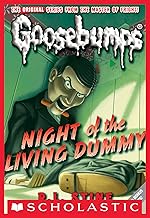Goosebumps

A Detailed Review of the Classic Goosebumps Series
R.L. Stine’s Goosebumps series, first published in 1992, has become a cornerstone of children's horror literature, capturing the imaginations of young readers for decades. With its unique blend of suspense, fright, and humor, the series not only entertained millions of readers but also introduced an entire generation to the world of horror. As we dive into a review of the Classic Goosebumps books, we’ll explore the writing style, themes, characters, and lasting impact of this series on both its audience and the genre as a whole.
The Concept of Goosebumps Series
At its core, the Goosebumps series revolves around young protagonists who face supernatural, eerie, and often dangerous situations. Each book is a standalone story, though they share common themes like haunted houses, vengeful spirits, creepy creatures, and items with dark powers. The tagline “Reader beware, you’re in for a scare” is emblematic of the kind of thrilling, edge-of-your-seat adventure readers can expect, often with a chilling twist ending that leaves readers both surprised and satisfied.
R.L. Stine has an uncanny ability to balance fear with humor, making the stories palatable for a younger audience without losing the thrills. His writing style is straightforward and engaging, which makes the books accessible to young readers while maintaining the suspenseful atmosphere that characterizes horror fiction. Stine’s choice to set the stories in ordinary suburban settings, where the supernatural elements feel completely out of place, enhances the eeriness and makes the threats more relatable.
Storytelling and Themes
While the Goosebumps series is undoubtedly known for its spooks and chills, its themes often tap into universal fears and anxieties that children and even adults can relate to. Themes of loss of control, fear of the unknown, and the consequences of reckless curiosity are prevalent throughout the books. These elements tap into psychological horror, creating not only fear but a sense of moral dilemma as characters are often faced with choices that have significant consequences.
One key feature of the Goosebumps series is its clever use of twist endings. Stine mastered the art of the surprise conclusion, often flipping the entire narrative on its head in the final pages. This technique of unexpected reversals is a hallmark of the series and has kept readers hooked, eager to find out what happens next. The twist endings also add to the sense of unpredictability, ensuring that no two Goosebumps books feel exactly alike.
Characters and Horror Elements
The characters in Goosebumps are often typical middle-grade children: adventurous, curious, and sometimes naïve. These relatable protagonists are thrust into strange and often terrifying situations, where their resourcefulness, courage, and sometimes even their naiveté are put to the test. This creates tension in the stories as readers are asked to imagine how they would react in similar circumstances.
The supernatural elements are varied, but they consistently provide a sense of unease. From haunted masks and possessed toys to creepy creatures like ghouls, werewolves, and killer plants, the series doesn’t shy away from exploring a wide range of eerie phenomena. This diversity in horror elements ensures that each book feels fresh and exciting, with no two stories feeling like a repeat of the last.
In addition, the Goosebumps series often uses physical horror—creepy settings like abandoned houses, dark forests, or ominous carnival grounds—to create a sense of isolation. These atmospheric settings enhance the terror and play into the fear of the unknown. The monsters or entities in the stories are often not fully explained, keeping the mystery and danger lurking just out of sight.
Lasting Impact and Legacy
Though Goosebumps was written for children, it transcended age groups, attracting both young readers and nostalgic adults. The books’ ability to tap into universal emotions of fear, curiosity, and wonder made them timeless. Beyond the books, the Goosebumps series expanded into television shows, films, and a variety of merchandise, which further cemented its place in pop culture.
The series is also noteworthy for its contribution to children's literature. By introducing children to horror in a safe and controlled environment, Stine allowed readers to explore their fears and anxieties in a way that was both entertaining and thought-provoking. It was a gateway for many young readers to dive deeper into the genre of horror, encouraging them to explore more mature works in the future.
Conclusion
The Classic Goosebumps series remains one of the most iconic children's horror series of all time. With its ingenious twists, relatable characters, and genuinely unsettling supernatural elements, the series has earned its place in literary history. R.L. Stine's ability to mix humor with horror, as well as his talent for creating unexpected conclusions, made the Goosebumps series both addictive and unforgettable. For those who grew up with the books, Goosebumps represents not just a thrilling adventure but a formative experience that opened the door to an entire world of speculative fiction.
Ultimately, Goosebumps is more than just a horror series for children. It’s a testament to the power of storytelling, the thrill of the unknown, and the lasting allure of a good scare.
- Hits: 28